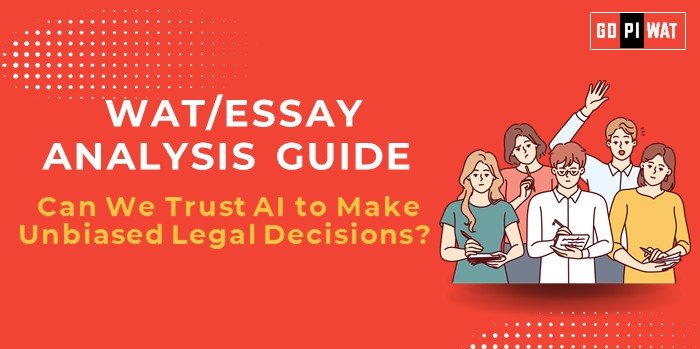📋 Written Ability Test (WAT)/Essay Analysis Guide: Can We Trust AI to Make Unbiased Legal Decisions?
🌐 Understanding the Topic’s Importance
AI’s role in legal systems challenges traditional decision-making frameworks, offering efficiency but raising ethical questions about justice and fairness. For B-school students, this topic connects deeply with ethics, governance, and innovation management.
🕒 Effective Planning and Writing
- Time Allocation: Planning (5 min), Writing (20 min), Review (5 min).
- Word Count: Introduction (60 words), Body (350 words), Conclusion (60 words).
💡 Introduction Techniques
- Contrast Approach: “AI offers precision in legal decisions but risks deepening societal biases—can trust and technology coexist in courts?”
- Solution-Based: “Integrating AI into judicial systems requires balancing its efficiency with ethical safeguards.”
📚 Structuring the Essay Body
Achievements:
- Highlight AI’s efficiency and consistency, e.g., faster case resolutions and cost savings.
Challenges:
- Discuss biases, lack of transparency, and accountability gaps.
Future Outlook:
- Propose balanced frameworks combining AI with human oversight and ethical guidelines.
📄 Concluding Effectively
- Balanced Conclusion: “While AI has transformative potential, its success depends on overcoming biases and ensuring ethical governance.”
- Global Comparison: “Lessons from Estonia’s AI courts and China’s scaled automation highlight both opportunities and risks.”
🔍 Recommendations for Sustainable Progress
- Implement AI auditing frameworks.
- Use diverse datasets to reduce bias.
- Ensure transparency in AI algorithms.
📄 Sample Short Essays
1. Balanced Perspective:
“AI in law can revolutionize decision-making, but ethical challenges like bias demand cautious implementation.”
2. Solution-Oriented:
“Combining AI efficiency with strict ethical guidelines can make justice both swift and fair.”
3. Global Comparison:
“Countries like Estonia lead the way in ethical AI use, offering models for fair and efficient justice systems.”


